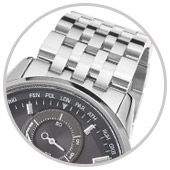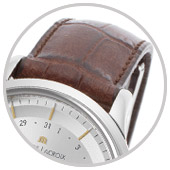Watch Care
Watch Care & Maintenance
Your newly purchased wristwatch is designed to provide you with accurate and reliable service over a long duration of time. However, like any other precision-crafted instruments such as automobiles, a watch does require periodic daily maintenance and care to ensure that it operates precisely. The frequency of when you should have your watch serviced is contingent upon the environment you live in as well the individual daily care given.
Whether you have an automatic, mechanical or quartz timepiece, a worn-out part or aged oil inside could cause your watch to start losing time or stop altogether. In addition the water-resistance of a watch is not permanently guaranteed. We recommend that you consider having your automatic, mechanical and quartz watch serviced every two to three years at an authorized service center.
 Standard Maintenance
Standard Maintenance
Most quartz watches require replacing the batteries every two to three years, so having your watch inspected and serviced at this time is optimal. Automatic and mechanical watches may require a complete overhaul after two or three years of use. The process involves the movement being removed from the case, completely disassembled and thoroughly cleaned, then reassembled, properly lubricated, timed and tested to factory accuracy. The movement is installed into the newly refinished case with a restored crown, seals and push-pieces. Afterwards the case is sealed and pressure-tested.
Everyday Care
Cleaning
![]()
Use a soft cloth daily to wipe off moisture, sweat and dirt daily on the case, case back and band when you take your watch off to maintain the durability of the case back and band.
Do not use solvents or harsh chemicals such as peroxide and bleach for cleaning your watch. This may create a chemical reaction on the case and band, resulting in the deterioration of the watch or create discoloration on the case and band.
Watch bands may require more attention since they directly touch the skin and could easily become soiled from perspiration and dust.
Since the watch band touches the skin directly, it may become damaged or dirty from perspiration, dust particles and other substances. The lack of care may accelerate deterioration of the band, cause skin irritation or stain the sleeve of apparel you're wearing.
Metal Bracelets Metal bracelets made of stainless steel, gold or ion-plated steel could develop rust, corrosion and exterior stains due to perspiration on the wrist and contact with various substances. A residue staining the skin could also result. Pure titanium bracelets may not corrode as easily as other metal bracelets, but should be cleaned regularly as well.
| Leather Straps | Silicone & RubberSilicone, Rubber and Urethane Straps are also susceptible to discoloration from sunlight and may be also damaged by solvents and extreme humidity in the atmosphere. Extremely wet bands in highly humid locations exposed to sunlight for extended periods may become discolored.
|
Water Resistance Safeguards
Whether your watch is water-resistant to 200 meters or 30 meters, there are certain measures to take to keep it running smoothly. There are several precautions to consider as well:
- Avoid having your watch come into any contract with water when the crown is pulled out.
- Avoid using the crown when the watch is wet.
- Do not place watch under running water from a faucet, even if the crown is locked and closed. The water pressure could create moisture inside the watch chamber.
- Keep the watch dry at all times when not in the water, to preserve the seal.
- The water-resistance of a watch is not guaranteed and the seal could be reduced over time. It is best to have the water-resistance periodically checked over time.
In The Bath, Sauna & Whirlpool: It is best to avoid wearing your watch, regardless of its water-resistance level in the bath, sauna, stream room or whirlpool. The steam, heat and soap could accelerate the deterioration of the water resistance performance of your watch. | SALTWATER SWIMMING & DIVING: Immediately clean your watch in fresh water after using it in salt water. Use a soft cloth or towel to dry it off. Keep the crown closed and locked and avoid placing the watch under running water. |
ADDITIONAL SAFEGUARDS:
Shocks
Avoid dropping your watch on hard surfaces which could create a shock to inside movement and cause the watch to stop working properly.
Extreme Temperature
The movement inside your watch may be affected by either extreme hot or cold temperatures.
Magnetic Fields
Your watch may be adversely affected by magnetic objects if in contact for long durations, causing it to lose or gain time. It's best to keep your watch away from your smart phone, TV, pc speakers, magnetic handbag clasp, hair drier, electric razor, bracelet or necklace with magnetic parts.


